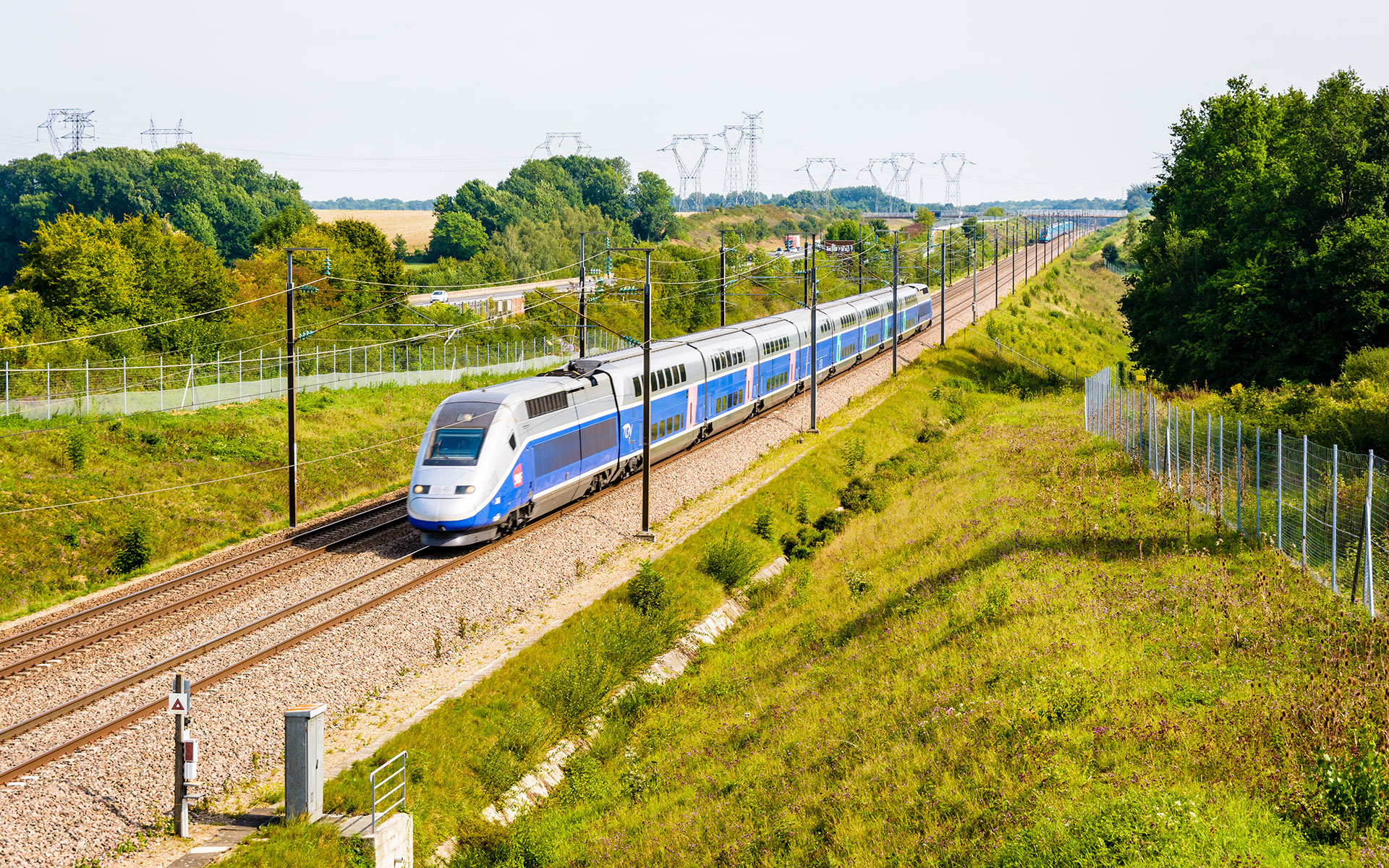Forty years of high-speed rail: Paris to Lyon
A double-deck French TGV speeds along the Sud-Est line about 40 km south-east of Paris (photo © Olrat / dreamstime.com).
This month marks the 40th anniversary of the opening of the first (and longest) stretch of the French high-speed railway linking Paris and Lyon. The 274 km line from Saint-Florentin (about 170 km south-east of Paris) to the northern outskirts of Lyon saw its first commercial services on 27 September 1981. The northern section of the route from Saint-Florentin to Paris opened a couple of years later.
The line is known as the LGV Sud-Est (with that LGV acronym meaning ligne à grande vitesse). In its early days it was often referred to in France as LN1, (meaning ligne nouvelle 1), presaging similar nomenclature in Britain many years later where the Channel Tunnel Rail Link was dubbed HS1.
Just two intermediate stations
With the inauguration of the main part of the route in September 1981, two dedicated high-speed stations were opened, each located some distance from the communities they nominally serve. They are Le Creusot TGV and Mâcon-Loché TGV. They remain today the only intermediate stations on the 427 km route from Paris to Lyon and are respectively 303 km and 363 km from Paris.
These two intermediate stations are interesting as early examples in Europe of an attempt to use high-speed rail to influence regional policy. But the arguments in each case were very different. In the case of Mâcon-Loché there was an articulate local campaign to make sure than the Saône Valley axis, well served by the traditional rail route from Paris to Lyon, was not disadvantaged by the opening of the new route. Without a station on the new route, businesses in the Mâcon area feared they would lose out.
Le Creusot had none of the transport connections enjoyed by the Saône Valley communities prior to the opening of the high-speed line. Its existing road and rail links were poor, and with the decline of the French iron industry, Le Creusot had growing unemployment and social deprivation. By linking the area into France’s first high-speed rail route, here was a chance for what is today often referred to as levelling up.
Faster journey times
Prior to the opening of the new line, express trains from Paris to Lyon generally took more than four hours, although four trains each day (three classified as Rapide and the other the prestigious TGV Le Mistral) were timetabled to dash along the old line in just under four hours. A special supplement was payable to use these extra-fast premium services.
With the opening of the new high-speed line from Paris to Lyon, service frequency increased, but so did fares. When the line was complete, trains regularly sped from Paris to Lyon in just over two hours and that schedule is maintained today.
As high-speed lines go, the Paris to Lyon route is actually very attractive. Part of its appeal is that it doesn’t tussle with the landscape in the way that some new-build high-speed routes do. There are no tunnels. When we last rode the route (in late November 2019), we were struck by the fine views of the wild Morvan massif. There’s a very strong sense of topography as the railway climbs gently to its summit at almost 500 metres above sea level.
Those who are less inclined to dash from Paris to Lyon can still follow the old line between the two cities, which is served by regular regional trains, taking about five hours for the journey. It’s a very fine ride, one which we describe in Route 7 in the 16th edition of our book Europe by Rail: The Definitive Guide.
Impact of LGV Sud-Est
What of the two intermediate stations which opened 40 years ago this month on that new fast line to Lyon? Mâcon-Loché TGV has been moderately successful, with a substantial new business park developed around the station. But remember this was an area which already enjoyed a healthy regional economy anyway. The picture at Le Creusot TGV is more mixed. Projections of sustained growth in passenger numbers have simply not been realized. Today, Mâcon-Loché TGV and Le Creusot TGV stations both enjoy half-a-dozen trains each day to Paris plus a once-daily direct train to Brussels.
With a fierce debate in Britain around a likely new dedicated high-speed line from London to Birmingham and beyond (called HS2), it’s instructive to look back at France’s experience with LGV Sud-Est. Forty years on, the French project is viewed as having been a considerable success, freeing up capacity for freight and passenger trains on the legacy network, encouraging modal shift from air and road to rail, and transforming the relationship between the two key economic hubs of Paris and Lyon.
Forty years is a long time in the operation of a railway and work is now underway to upgrade the existing infrastructure. New signalling and track renewal projects are underway, with much of the work taking place at night, so minimizing impact on what by day is one of Europe’s busiest stretches of high-speed railway. The opening of the first stretch of the Paris-Lyon route in 1981 fired the starting gun in the race to develop high-speed rail infrastructure across Europe. In the following years Spain and Italy joined France in demonstrating how high-speed rail could be a powerful tool in promoting economic growth and regional development.






About The Authors
Nicky Gardner and Susanne Kries
Nicky and Susanne manage hidden europe, a Berlin-based editorial bureau that supplies text and images to media across Europe. Together they edit hidden europe magazine. Nicky and Susanne are dedicated slow travellers and the authors of the book Europe by Rail: The Definitive Guide. The 17th edition of that book was published in 2022 and reprinted in July 2023. You'll find a list of outlets that sell the book on this website.